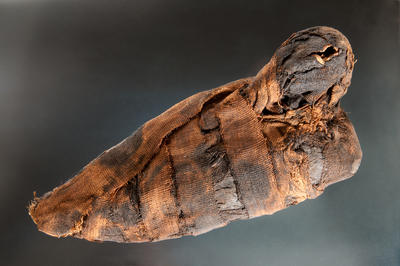Animal mummy, Ibis
Production date
Circa 30 BCE-395 CE
Country
Egypt
See full details
Object detail
Description
Ibis, sacred Egyptian, mummified. Wrapped in coarse linen strips. Damaged area to the Ibis' skull. Was originally held in glass case with pottery sherd (remnant of pottery jar lid Ibis may have been originally interred in).
Classification
ARCHAEOLOGY Egyptian
Production date
Circa 30 BCE-395 CE
Production place
Measurements
L240mm x W90mm x D95mm
Media/Materials description
Bone (Animal Remains)
Feathers (Animal Remains)
Species name: Threskiornis aethiopicus (Lathan, 1790)
Linen (cloth)
Feathers (Animal Remains)
Species name: Threskiornis aethiopicus (Lathan, 1790)
Linen (cloth)
History and use
Mummification and mummy wrapping were skills not just reserved for human bodies. In ancient Egypt, a wide variety of animals were mummified, ranging from mice to bulls. Cats, dogs, snakes, baboons, and especially birds were the most popular mummified animals. Mummified animals were usually bought as offerings to particular gods. Thus, a cat may be offered to Bastet, an Ibis to Thoth, a falcon to Horus.
This Ibis (Threskiornis aethiopicus) mummy may have been donated to the Queensland Museum in 1913 by Leonard Stevenson Loat, in exchange for ethnological specimens. Loat was an Egyptologist who discovered an ibis cemetery at Abydos. The mummified ibis was placed inside a terracotta pot, which itself was placed in a catacomb.
This Ibis (Threskiornis aethiopicus) mummy may have been donated to the Queensland Museum in 1913 by Leonard Stevenson Loat, in exchange for ethnological specimens. Loat was an Egyptologist who discovered an ibis cemetery at Abydos. The mummified ibis was placed inside a terracotta pot, which itself was placed in a catacomb.
Associated person
Registration number
H6451.1



